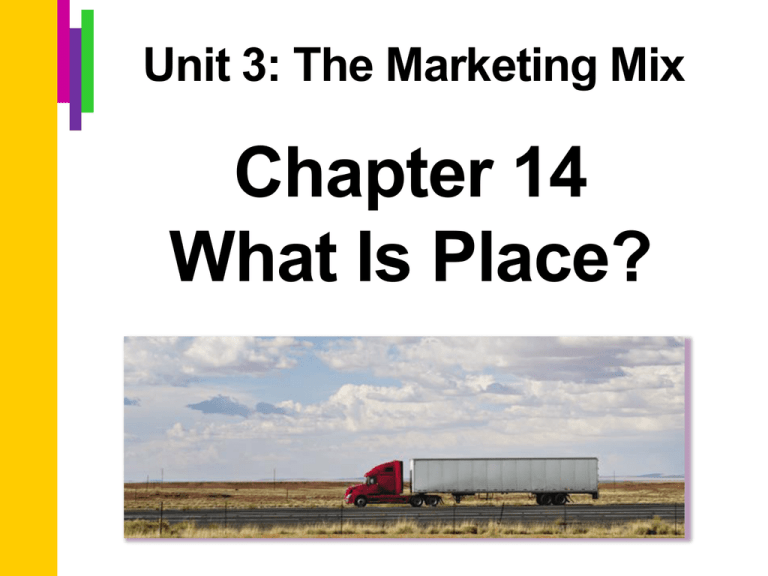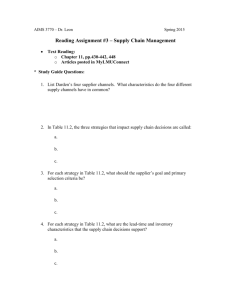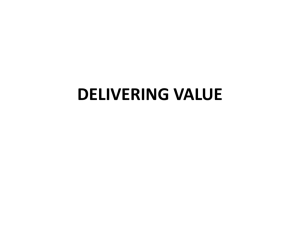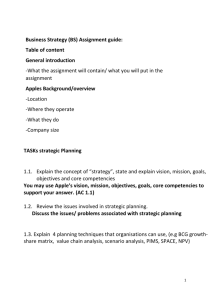Channel of Distribution Supply Chain
advertisement

Unit 3: The Marketing Mix Chapter 14 What Is Place? Learning Goals Explain the purpose of channel distribution Explain the difference between a wholesaler and a retailer and why a business would use each Explain why a company would use an agent or broker Distinguish between direct distribution and indirect distribution Describe the four components of physical distribution Summarize the advantages and disadvantages of each of the five modes of transportation Explain how businesses process orders Day 1 Response Journal Have you ever gone to a store (or online) to buy a product and found it was out of stock? What was your reaction? Why do you think this situation happens? *** Save As Jan 8 in your Response Journal folder *** What Is Place? Place is one of the Four Ps of the marketing mix Place is about making sure the … right products get to the right place at the right time and in the right quantities Place Decisions The purpose of place decisions are to … make products conveniently available to the target market Place decisions include; Location Hours of operation Channels of distribution Transportation Channels of Distribution A _______________________ Channel of Distribution is the route a good takes from its original source to its final customer The channel of distribution for most consumer goods involves three types of businesses; A Producer A Wholesaler A Retailer Wholesalers and Retailers _______________ Intermediaries are the businesses between the original source of the product (the producer) and the customer (you) Two types of intermediaries are; Wholesalers Retailers Wholesalers and Retailers A _______________ is a business that buys Wholesaler products from a producer, and then sells them to another business Wholesalers are … B2B businesses Also called distributors A ____________ is a business that buys Retailer products from a producer or a wholesaler, and then sells the product to the final customer in the consumer market Wholesalers and Retailers Retailers are … B2C businesses Stores, restaurants, theatres, etc. Also ______________ retailers Nonstore A nonstore retailer is a business that sells directly to consumers through ways other than a retail store E.g. e-tailers, TV shopping channels, mail-order catalogues, sales reps, etc. Channels of Distribution Think of an apple you ate recently. What route did the apple take to get to you? The apple started out in an apple orchard owned by an apple farmer (_____________) Producer The apple farmer then sells the apples to an apple buyer (______________) Wholesaler The apple buyer then sells apples to your local grocery store (____________) Retailer You then go to the grocery store and buy the apple Channels of Distribution You could have bought the apple directly from the apple farmer However, you may live very far away from any apple farms The apple buyer and the grocery store make the apple convenient to you The apple orchard, apple buyer, and the grocery store are the channel of distribution for the apple Channel of Distribution Supply Chain A channel of distribution is like a chain that links a raw material to the final customer For this reason, another term for channel of distribution is _________________ Supply Chain Each step in the channel of distribution can be visualized as a link in a chain The supply chain is visualized vertically, with the raw material at the top and the final customer at the bottom Products start at the top and move from link to link to reach the final customer Supply Chain Each step in a supply chain can be referred to as a ______________ Segment In the simple supply chain, the producer, wholesaler, retailer, and final consumer are segments of the supply chain In a supply chain, each segment is the customer of the preceding segment Similarly, each segment is the supplier of the following segment Supply Chain Supply Chain Supply chains can be _______ Long or ________ Short _____________ usually have very short Services supply chains because the service producer provides the service directly to the consumer ________________________ often have Manufactured Goods very long supply chains because hundreds of raw materials and manufactured parts are needed to make the goods A Common Channel of Distribution Agents and Brokers Another type of intermediary is the _________ Agent or _________ Broker An agent is an intermediary who brings buyers and sellers together Broker is another term for agent They connect buyers and sellers They never own or physically handle the product May be hired by the seller or the buyer They know the market extremely well Often used in situations where it is hard for buyers and sellers to find each other E.g. may be used when a Canadian manufacturer wants to sell in a foreign country Day 1 Assigned Work Students please complete the following; Watch the Retailing & Wholesaling Case study video Mother’s Market & Kitchen Day 2 Video & Discussion Watch the Walmart Supply Chain Video and be prepared to discuss afterwards. Types of Distribution There are 2 types of distribution; 1. ____________________ is a channel of Direct Distribution distribution with no intermediaries Many services have direct distribution The service producer “distributes” the service directly to the service user E.g. A manicure is not produced until the manicurist actually files and polishes the nails of a customer Buying products from a local farmer is also direct distribution (because you are buying direct from the producer) Types of Distribution 2. ___________________ Indirect Distribution is a channel of distribution with more than one intermediary Most goods have indirect distribution, that is, most producers use one or more intermediaries Role of Intermediaries Choosing the best channel of distribution for a product is critical to the success of the product A producer might have the best product in the world, but poor distribution decisions can cause the product to fail Why do producers use intermediaries? Because intermediaries provide many important services to producers Distribution Intermediaries are experts at _______________ Most producers are experts at making a product, not at distributing it Remember distribution includes shipping, inventory and stocking Role of Intermediaries One of the major services that intermediaries provide is __________________________ Facilitating Exchanges _____________ means to make an action Facilitate easier Intermediaries make the exchange process easier Intermediaries facilitate exchanges for both consumers and for producers Customers: One Place, Many Goods Suppose you need apples, bread, canned soup, and eggs If there were no intermediaries, you would have to go to the apple orchard for the apples, the bakery for the bread, the soup factory for the soup, and the chicken farm for the eggs Instead, an intermediary, the grocery store, can facilitate these purchases for you For customers, intermediaries facilitate exchanges by; Gathering many types of products in one place Customers: One Place, Many Goods The grocery store takes on the task of contacting the apple orchard, the bakery, the soup factory, and the chicken farm The grocery store buys products from the four producers The grocery store handles the four transactions with those producers You now have the convenience of picking up the apples, bread, soup, and eggs in one place You also only have one transaction, that is, with the grocery store Producer: One Transaction, Many Customers Now think of the producer's situation The apple farmer wants to sell as many apples as possible Imagine that there are no intermediaries In order to sell his apples, the farmer would have to go to where the customers are Suppose the farmer wants to sell 200 kilos of apples The most that one customer might buy is 20 kilos, therefore, the farmer would have to handle at least 10 individual transactions with at least 10 separate customers Producer: One Transaction, Many Customers Now think of how an intermediary could facilitate exchanges for the farmer The farmer contacts the grocery store The grocery store buys all 200 kilos of apples The farmer has one transaction The grocery store then handles the 10 or more individual transactions with each customer For producers, intermediaries facilitate exchanges by; Enabling producers to sell to one buyer (the wholesaler) Physical Distribution How do goods get from one step of a channel of distribution to the next? Goods must be physically carried to the next step in the chain Modes of transportation carry goods through the chain ______________________ is the movement Physical Distribution of goods in the distribution channel Physical distribution is needed to move raw materials to factories, finished goods from factories to warehouses, and finished goods from warehouses to retail stores Physical Distribution Physical distribution is also called __________ Logistics Logistics is a general term for the handling of details of any complex activity Logistics for physical distribution consists of handling the details involved in ____________ Physically moving goods Components of Physical Distribution Physical distribution has 4 components; 1. Products to be shipped 2. Channel members 3. Transportation companies 4. Warehouses 1. Products To Be Shipped Products are the reason for physical distribution and are the items that need to be shipped Products to be shipped include; Raw materials Manufactured goods Finished consumer goods Products that are shipped are also referred to as; Freight Cargo Merchandise Shipment/Order 2. Channel Members _______________________ are the Channel Members businesses in the channel of distribution (supply chain) Businesses need to distribute their products Usually own the products that need to be shipped Suppliers are responsible for making sure that their products are shipped to their customers in the most efficient, economical way Some suppliers have their own transportation vehicles for moving their goods, and some hire transportation companies to move their goods for them 3. Transportation Companies ________________ Transportation is the process of physically moving goods from buyer to seller Also called _____________ Shipping Transportation companies are the companies that own the trucks, trains, planes, pipelines, or ships, and they provide the service of transportation Channel members often hire transportation companies to move their products However, the transportation companies are not part of the distribution channel because they do not own the goods they are shipping Carrier Another term for transportation company is __________ • E.g. Canada Post, FedEx, UPS, etc. 4. Warehouses Products must be stored at various points along the channel of distribution A ______________ is a building where large Warehouse quantities of products are stored until needed for shipping Products in a warehouse are _______________ Inventory Products are usually transported from a warehouse to companies in the next segment of the supply chain • E.g. the ingredients for Pepsi are stored in a warehouse until needed at the production plant. After production, cans and bottles of Pepsi are stored in another warehouse until retailers need them to sell to consumers Modes of Transportation A mode of transportation is a ________ Type of transportation The 5 major modes of transportation are; 1. Truck 2. Ship 3. Train 4. Plane 5. Pipeline Modes of Transportation Each mode has advantages and disadvantages Companies must decide which modes of transportation best meet their needs Considerations in choosing the best mode of transportation are; Speed Cost Flexibility in reaching the location Often a combination of transportation modes is used Day 2 Assigned Work Students please complete the following; Modes of Transportation Worksheet Handout provided Day 3 Response Journal What different modes of transportation do you use to move yourself from place to place? Do you choose different modes in different situations? Explain. *** Save As Jan 12 in your Response Journal folder *** Distribution of Services and Ideas Services and ideas also need to be transported to customers The goods needed for performing services and ideas, such as furniture for a doctor’s office, are transported through one of the five modes of transportation discussed yesterday ______________ are most often _______________ Services “Transported” by the people who perform them People do the service E.g. the medical examination (the service itself) is "transported" to you when the doctor actually performs the examination Distribution of Services and Ideas _________ are delivered to the target Ideas market by _________ Media The target market for ideas is often called an ____________ Audience Media that carry ideas includes radio, television, the Internet, social media, newspapers, magazines, billboards, etc. The Distribution Process The distribution process begins when a buyer contacts a seller E.g. The buyer might be a retailer that needs more jeans; and the supplier might be a jeans manufacturer or a wholesaler of clothing The buyer and seller then negotiate the terms of sale _________________ are the conditions governing a Terms of Sale sale and could include discounts, transportation arrangements, date of delivery, etc. Purchase Order Then a purchase order is written A _______________________ is a document Purchase Order (PO) authorizing the purchase and delivery of certain goods at specific prices and times The document has a PO number that identifies the order The PO becomes a sales contract between the buyer and seller Contract • A _____________ is a legal written agreement People representing both the selling and buying companies sign the contract Purchase Order When a company needs particular items, that company writes up a purchase order The purchase order starts the movement of goods from the supplier to the buyer The buying company sends a signed PO to the supplier The supplier receives the PO The supplier signs the PO, which validates it as a contract A confirmation is sent from the supplier back to the ordering company It says the order has been received, will be filled and sent Order Processing _____________________ is receiving and Order Processing filling orders A ______________ is created after PO Pick Ticket received A pick ticket is a list of all the items in one order The orders are then picked by the warehouse staff Items are packaged, labelled, and shipped Bar-code scanning of each item helps keep track of orders and inventory Computerized Order Processing Order processing can be automated through _______________ linkages Computer The buyer sets up computer linkage with the supplier The buyer’s computer then sends a message to the supplier’s computer when inventory is low The supplier’s computer orders enough goods to resupply the buyer The supplier then ships those goods to the buyer Channel Management and Physical Distribution The role of channel management is to oversee the physical distribution of goods by selecting and evaluating the following factors; a) Shipping mode b) Warehouse storage c) Inventory control d) Risk a) Shipping Mode Choosing a shipping mode requires that companies think about several factors; Cost Perishability of goods Transportation time Security E.g. suppose a company in Africa ships diamonds to Montreal. Because they are lightweight and very valuable, the company will likely ship the diamonds by air. Transporting by truck, ship, or train takes more time and may impact security b) Warehouse Storage Channel management decisions include choices about warehouse ______ Sites and decisions about whether to _________ or Build ________ Lease warehouses E.g. Loblaws has multiple warehouses in strategic places across the country, because multiple warehouses allow them to quickly move products to Loblaws stores and meet customer demand c) Inventory Control With motivation to keep cash flow positive and increase profits, inventory control becomes vital to a company's success To increase profits and save money, producers, wholesalers, and retailers seek to limit large quantities of inventory in storage c) Inventory Control Just-in-time systems are a way for manufacturers and retailers to avoid having too much inventory on hand ____________________ is a distribution Just-In-Time (JIT) strategy where materials should not be delivered to the factory until the moment they are needed for production • The goal is to have no materials, supplies, or merchandise in inventory c) Inventory Control The JIT production strategy is based on the automatic reorder system In a factory, when inventory of a material falls to a specific number, an electronic data interchange (EDI) message is sent to the materials supplier Electronic Data Interchange (EDI) ___________________________________ is the business-to-business exchange of data (information) by way of computers using standard formats EDI messages include purchase orders, shipping notices, invoices, credit memos, and other documents d) Risk As distribution expands in size and complexity, risk reduction becomes a key focus of channel management E.g. think about a German company that makes pinsetters for bowling alleys. Producing pinsetters involves buying parts from over 200 vendors on three continents. How many disruptions can occur in the shipment of these parts? Plenty! Disruptions can be as simple as production delays that impact shipping time, or they can be as major as production loss due to fire, port closings, incorrect paperwork holding up products at a port, or natural disasters d) Risk All companies can take actions to reduce and manage risk, such as; Redesigning the supply chain Increasing your understanding of foreign trade issues Implementing a computerized inventory control system Day 3 Assigned Work Students please complete the following; K&U Questions #1, 3 & 4 on page 210 Thinking Question #4 on page 210 Application Questions #3, 4 & 5 on page 211 ***Save As Ch 14 Day 3 in your Unit 3 folder***





